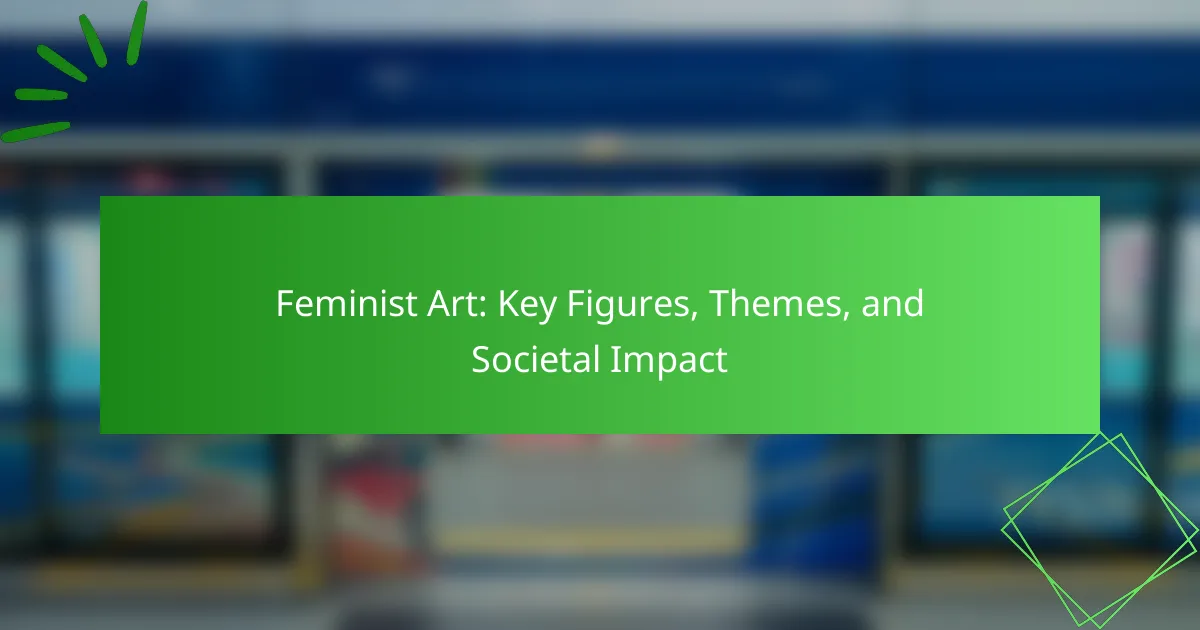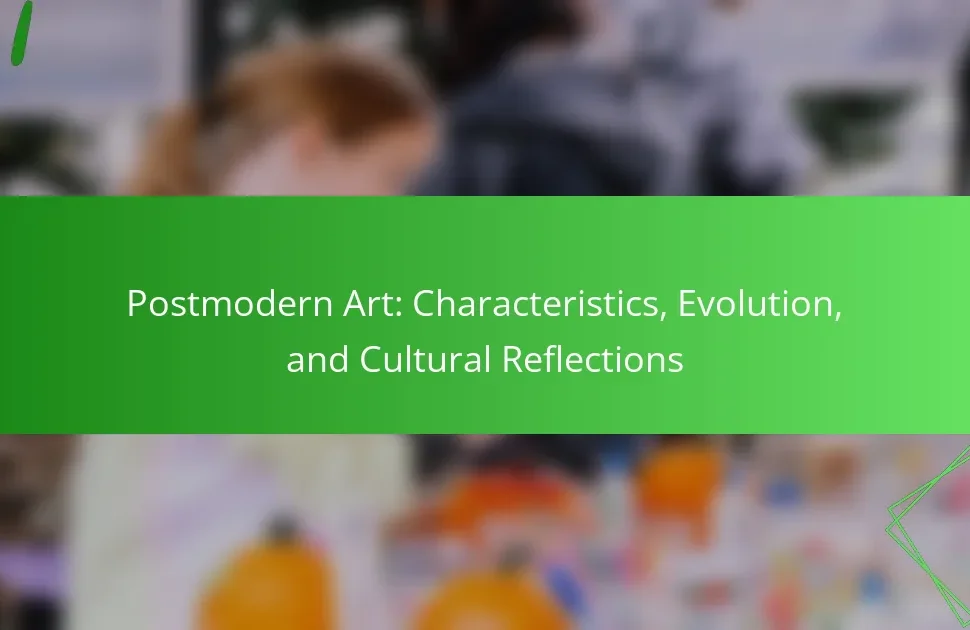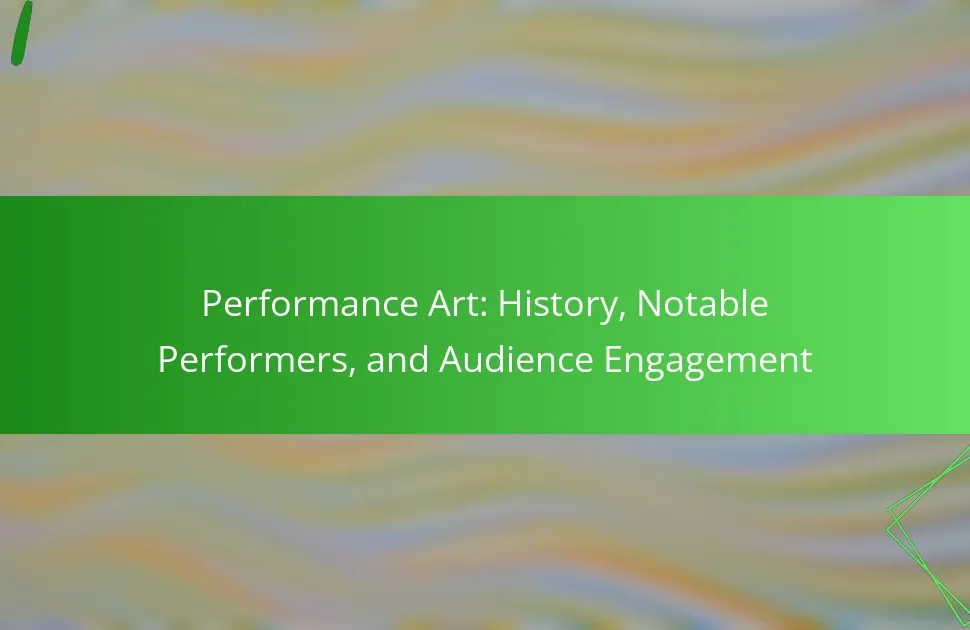Feminist art challenges societal norms and promotes gender equality through diverse themes and representations. Key figures like Judy Chicago and Cindy Sherman have significantly influenced this movement. The exploration of identity, body politics, and intersectionality highlights the ongoing impact of feminist art on contemporary cultural discourse. Additionally, the challenges faced by feminist artists in a male-dominated art world underscore the need for continued advocacy and awareness.

What are the fundamental principles of Feminist Art?
Feminist art is driven by principles of gender equality, representation, and social critique. Key figures include Judy Chicago and Cindy Sherman, who challenge traditional narratives. Themes often explore identity, body politics, and societal norms. The societal impact of feminist art reshapes cultural discourse, promoting awareness and activism.
How do these principles challenge traditional art narratives?
Feminist art principles challenge traditional narratives by introducing diverse perspectives and questioning established norms. These principles emphasize the value of women’s experiences and highlight systemic inequalities. Key figures like Judy Chicago and Barbara Kruger use their art to critique patriarchy and promote inclusivity. Their work often incorporates personal and collective histories, reshaping the discourse around gender and identity in art. As a result, feminist art fosters a more nuanced understanding of culture, encouraging dialogue that transcends conventional boundaries.
Which key movements have influenced Feminist Art?
Feminist Art has been significantly influenced by movements such as the Women’s Liberation Movement, which emphasized gender equality, and the Civil Rights Movement, advocating for broader social justice. Additionally, the Postmodern Movement challenged traditional narratives, allowing for diverse female perspectives. The performance art movement also played a vital role, using the body as a medium for feminist expression. These movements collectively shaped the themes of identity, representation, and empowerment in Feminist Art.

Who are the most significant figures in Feminist Art?
Significant figures in Feminist Art include Judy Chicago, Cindy Sherman, and Barbara Kruger. Judy Chicago is known for her installation “The Dinner Party,” which highlights women’s contributions to history. Cindy Sherman’s photography explores female identity and representation, while Barbara Kruger uses text and imagery to critique societal norms. Each artist has profoundly influenced the discourse on gender and identity in art, shaping societal perceptions and inspiring future generations.
What contributions did artists like Judy Chicago make to the movement?
Artists like Judy Chicago significantly shaped the feminist art movement through their innovative approaches and themes. Chicago’s work, particularly “The Dinner Party,” highlighted women’s contributions to history and culture, creating a dialogue about gender and identity. She emphasized the importance of female experiences, using mixed media to challenge traditional narratives. Chicago’s influence extends to education, as she established programs that empowered women artists, fostering future generations in the feminist art landscape.
How did artists such as Yoko Ono and Frida Kahlo shape Feminist Art?
Yoko Ono and Frida Kahlo significantly influenced Feminist Art through their unique perspectives and themes. Ono’s work often challenged societal norms and emphasized women’s voices, while Kahlo’s art explored identity and personal suffering, reflecting the female experience. Both artists used their platforms to advocate for women’s rights and social change, reshaping the art world and inspiring future generations. Their contributions highlight the intersection of art and feminism, emphasizing personal narratives and collective empowerment.
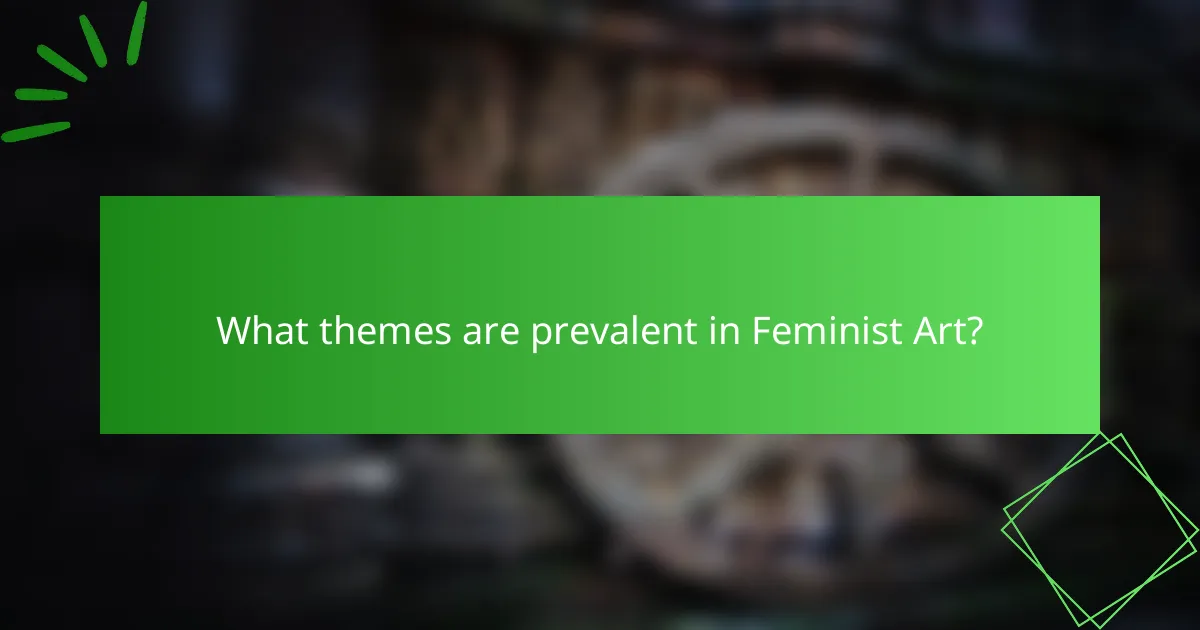
What themes are prevalent in Feminist Art?
Feminist art often explores themes of gender equality, identity, and societal roles. Key themes include the deconstruction of traditional gender norms, the representation of women’s experiences, and critiques of patriarchy. Artists like Judy Chicago and Barbara Kruger challenge societal expectations through their work. These themes have significantly impacted contemporary art and discussions around feminism.
How does Feminist Art address issues of identity and representation?
Feminist Art addresses issues of identity and representation by challenging traditional norms and showcasing diverse perspectives. It emphasizes women’s experiences and highlights marginalized voices through various mediums. Key figures like Judy Chicago and Barbara Kruger use their art to confront stereotypes and advocate for social change. This movement fosters dialogue about gender, race, and class, reshaping cultural narratives and promoting inclusivity. As a result, Feminist Art plays a crucial role in redefining representation in contemporary society.
In what ways does Feminist Art critique societal norms and gender roles?
Feminist Art critiques societal norms and gender roles by challenging traditional representations of women and advocating for gender equality. Artists use diverse mediums to expose and dismantle stereotypes, often invoking personal and collective experiences. For example, the use of body imagery confronts societal expectations, while installations may address issues like domestic violence. This art movement also emphasizes intersectionality, highlighting how race, class, and sexuality intersect with gender. Through these critiques, Feminist Art fosters dialogue and encourages societal change, making it a powerful tool for activism.
Which forms of media are commonly used in Feminist Art?
Feminist art commonly utilizes a variety of media, including painting, sculpture, photography, video, performance, and installation art. These forms allow artists to express themes of gender, identity, and social critique. For example, performance art often engages audiences directly, challenging societal norms. Photography can document women’s experiences, while installation art creates immersive environments that provoke thought. Each medium contributes uniquely to the feminist dialogue, enhancing the impact of the message conveyed.
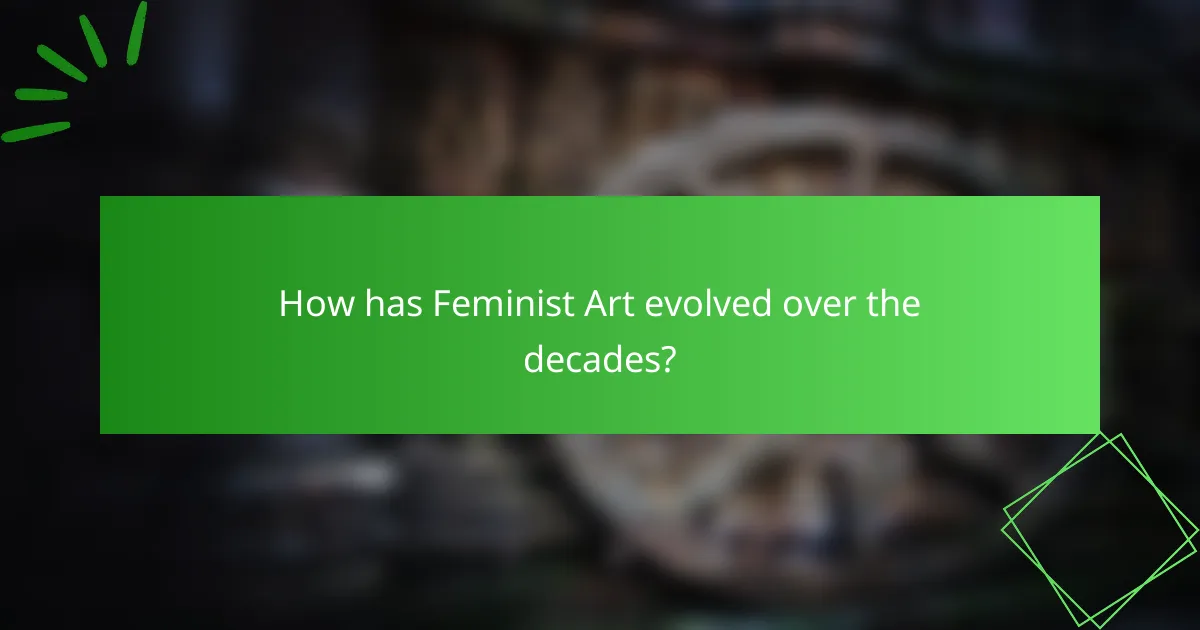
How has Feminist Art evolved over the decades?
Feminist Art has evolved significantly, reflecting societal changes and women’s roles. Key figures like Judy Chicago and Barbara Kruger introduced themes of gender identity and empowerment. Over the decades, movements have shifted from focusing on women’s experiences to broader issues like intersectionality and inclusivity. The societal impact includes raising awareness about gender inequality and inspiring future generations of artists.
What role did the 1970s feminist movements play in shaping contemporary Feminist Art?
The 1970s feminist movements significantly influenced contemporary Feminist Art by challenging traditional gender roles and promoting women’s perspectives. Artists like Judy Chicago and Miriam Schapiro used their work to address issues such as identity, representation, and social justice. This era emphasized collaboration and community, leading to the establishment of feminist art collectives that fostered new forms of expression. The incorporation of personal narratives and experiences became a hallmark of Feminist Art, reshaping the art world and encouraging ongoing dialogues about gender and power dynamics.
How is Feminist Art being reinterpreted in the 2020s?
Feminist Art is being reinterpreted in the 2020s through diverse mediums and themes that reflect contemporary social issues. Artists are exploring intersectionality, body politics, and digital activism. Key figures like Jennifer Packer and Tatyana Fazlalizadeh challenge traditional narratives, using personal experiences to address broader societal concerns. The impact of social media amplifies these voices, allowing for global conversations around gender and identity. As a result, Feminist Art continues to evolve, engaging new audiences and fostering inclusivity.
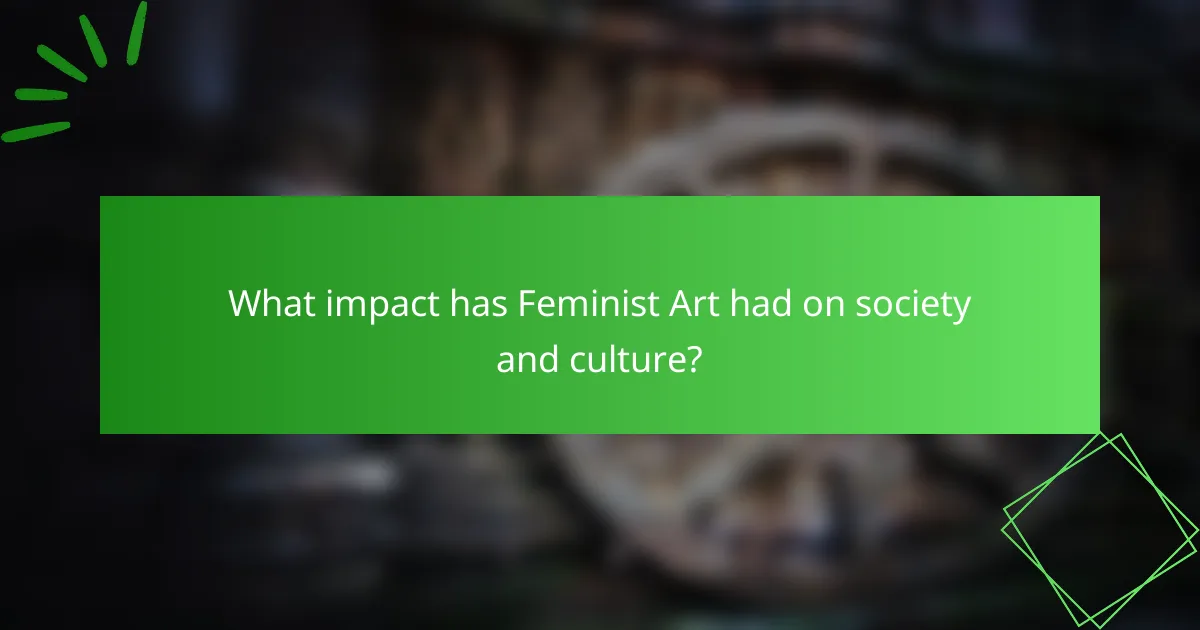
What impact has Feminist Art had on society and culture?
Feminist art has significantly reshaped societal and cultural norms by challenging gender stereotypes and advocating for women’s rights. Key figures like Judy Chicago and Barbara Kruger have used their work to highlight issues such as patriarchy and inequality. This movement has introduced themes of identity, body politics, and intersectionality, influencing contemporary art and sparking dialogues about gender roles. As a result, feminist art has fostered greater awareness and acceptance of diverse perspectives in society.
How does Feminist Art influence public discourse on gender equality?
Feminist art significantly shapes public discourse on gender equality by challenging societal norms and promoting awareness. Key figures like Judy Chicago and Barbara Kruger use their work to highlight women’s experiences and advocate for equality. Themes often include identity, representation, and power dynamics, which resonate widely, inspiring activism. As a result, feminist art fosters critical conversations and influences policy changes related to gender issues.
What are some notable exhibitions that have showcased Feminist Art?
Notable exhibitions that have showcased Feminist Art include “The Dinner Party” by Judy Chicago, “WACK! Art and the Feminist Revolution,” and “Radical Women: Latin American Art, 1960-1985.” These exhibitions highlight key themes such as gender identity, societal roles, and the intersection of art and activism. “The Dinner Party” features place settings for influential women, emphasizing their contributions. “WACK!” explores the impact of feminist artists in the 1970s, while “Radical Women” showcases underrepresented Latin American artists. Each exhibition has significantly influenced the discourse surrounding Feminist Art.
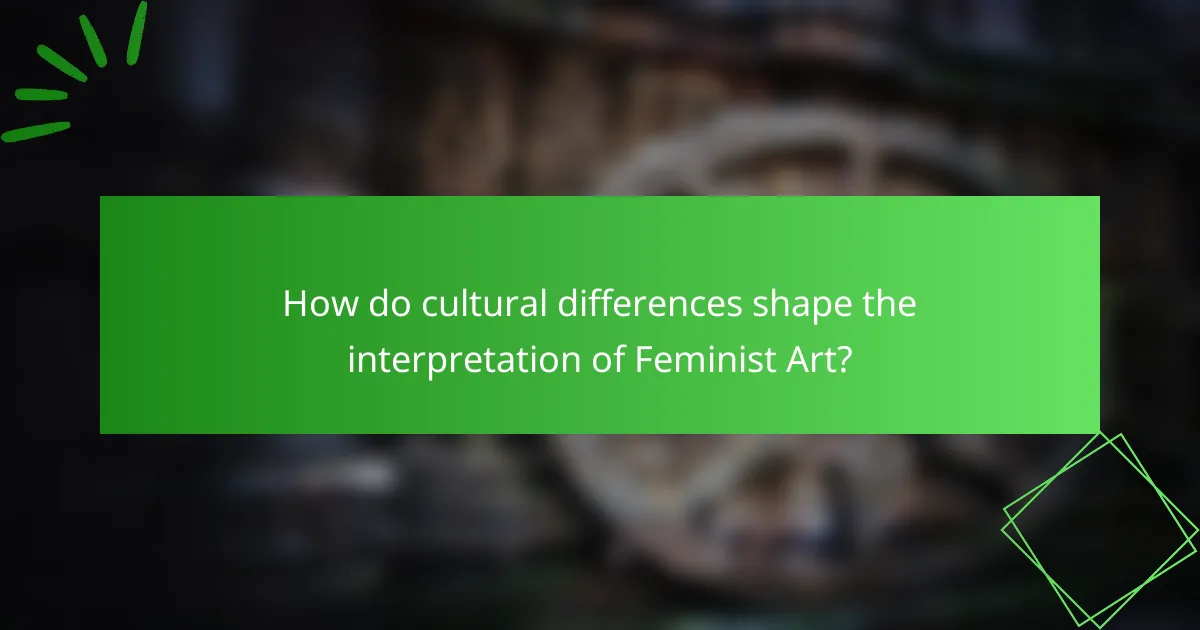
How do cultural differences shape the interpretation of Feminist Art?
Cultural differences significantly influence the interpretation of Feminist Art. These variations shape how themes of gender, identity, and empowerment are perceived across different societies.
In Western contexts, Feminist Art often emphasizes individualism and personal narratives. Artists like Judy Chicago and Barbara Kruger challenge societal norms through bold visuals and text. In contrast, non-Western interpretations may focus on communal experiences and collective struggles, reflecting local cultural values.
Global movements, such as the intersectionality of race and gender, further complicate interpretations. For instance, artists from diverse backgrounds incorporate unique cultural symbols, leading to varied understandings of Feminist Art’s impact.
As a result, the reception of Feminist Art is not uniform; it evolves based on cultural contexts, highlighting the significance of local narratives within the global feminist discourse.
In what ways do regional contexts affect the themes explored in Feminist Art?
Regional contexts significantly influence the themes in Feminist Art by reflecting local cultures, histories, and social issues. For instance, Western feminist art often addresses themes like gender equality and body autonomy, while artists from non-Western regions may focus on colonialism, cultural identity, and intersectionality. These variations arise from unique socio-political landscapes and historical experiences. As a result, Feminist Art becomes a diverse expression of women’s experiences shaped by their environments. This diversity enriches the discourse around feminism, making it a global movement with localized expressions.
How do global movements resonate within local Feminist Art practices?
Global movements significantly influence local feminist art practices by providing frameworks for activism and expression. Artists often draw inspiration from global feminist discourses, adapting them to address local issues. For instance, themes of body autonomy and gender equality resonate universally but manifest uniquely in different cultural contexts.
Key figures in feminist art, such as Judy Chicago and Yoko Ono, have inspired local artists to challenge societal norms through their work. These artists utilize various mediums to reflect local struggles while aligning with broader feminist movements.
Moreover, local feminist art often incorporates unique attributes that reflect specific cultural narratives. This blending of global and local perspectives enriches the feminist art landscape, fostering a diverse dialogue on gender and identity.
As a result, feminist art becomes a powerful tool for social change, connecting local communities to global movements while addressing unique societal challenges.
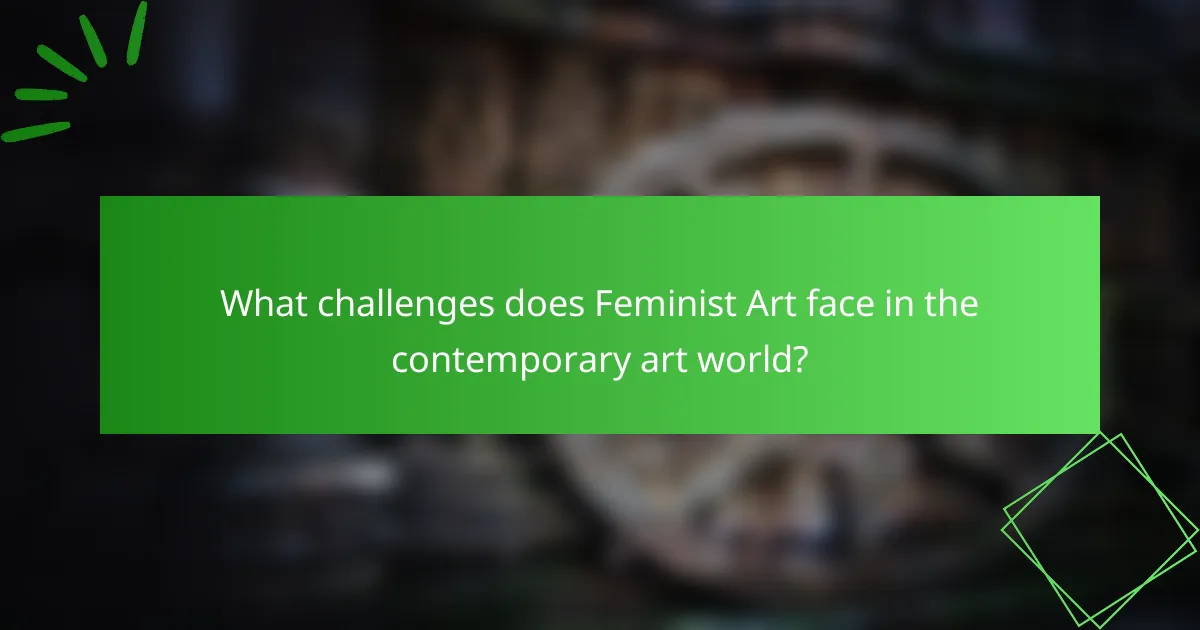
What challenges does Feminist Art face in the contemporary art world?
Feminist Art faces significant challenges in the contemporary art world, including institutional bias and market undervaluation. Key figures often struggle for visibility amid a predominantly male-centric art scene. Themes of gender inequality and social justice may be marginalized, limiting their societal impact. Additionally, the commercialization of art can dilute the radical messages inherent in Feminist Art.
How do market dynamics affect the visibility of Feminist Art?
Market dynamics significantly influence the visibility of Feminist Art by shaping public perception and access. Economic conditions, cultural trends, and social movements directly affect how Feminist Art is promoted and received. For instance, during economic downturns, funding for art initiatives may diminish, reducing exposure for feminist artists. Conversely, during periods of heightened social awareness, such as the #MeToo movement, Feminist Art gains increased visibility, showcasing its relevance. The art market’s focus on diversity and inclusivity also enhances the prominence of feminist themes, allowing key figures to emerge and resonate within broader societal contexts.
What barriers do Feminist artists encounter in gaining recognition?
Feminist artists face significant barriers in gaining recognition, including gender bias, lack of institutional support, and limited access to funding. These obstacles hinder their visibility and opportunities in the art world. Gender bias manifests in the underrepresentation of women in galleries and exhibitions. Institutional support often favors established male artists, creating disparities in recognition. Additionally, funding opportunities are frequently skewed, limiting resources for feminist art projects. These challenges contribute to a persistent struggle for equality in the art community.
What strategies can be employed to support Feminist Art?
To support Feminist Art, strategies include promoting education, fostering community engagement, and increasing visibility. Educational programs can highlight key figures and themes, enriching understanding of the movement. Community initiatives can create platforms for female artists, encouraging collaboration and mentorship. Visibility can be enhanced through exhibitions and social media campaigns that celebrate feminist perspectives. These strategies collectively strengthen the societal impact of Feminist Art.
What best practices can emerging artists adopt in Feminist Art?
Emerging artists can adopt several best practices in Feminist Art to enhance their impact. They should focus on authentic self-expression, exploring personal narratives that resonate with broader feminist themes. Collaborating with other artists can foster community and amplify diverse voices. Engaging with audiences through interactive installations can create dialogue and challenge societal norms. Lastly, staying informed about feminist theory and history will deepen their artistic practice and contextual understanding.
